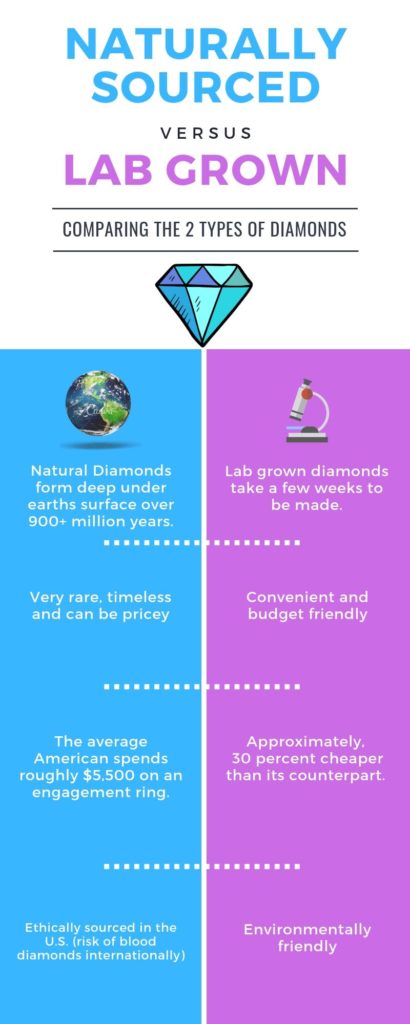Getting My Lab Grown Diamonds To Work
Table of Contents4 Simple Techniques For Lab Grown DiamondsMore About Lab Grown DiamondsMore About Lab Grown DiamondsThe 9-Minute Rule for Lab Grown Diamonds
As you take a trip closer to the Planet's core, pressure and temperature level increase, which develops the excellent stove for carbon to be transformed into diamond (rubies are the only gems to be made from totally one element). Via an enormous volcanic eruption, these diamonds were transported to the Planet's surface. It's approximated this procedure was fairly quick (more than likely throughout numerous hours), which permitted the rubies to stay intact without melting.The brief answer: carats gauge the mass of stones, karats gauge the pureness of gold. Carat: 1 carat weight amounts to 0.2 grams, regarding the weight of a paperclip (next time you see a picture of Mariah Carey's 35 carat weight interaction ring, simply imagine the worry of bring 35 paper clips around your finger daily).

Here are a few of the crucial advantages of lab expanded rubies and lab grown ruby jewellery:.
The Only Guide to Lab Grown Diamonds
Simply put, all-natural or earth-mined diamonds are crafted over numerous years beneath the Planet's crust from pure carbon incorporated with pressure and warmth. Developing rubies in a lab needs the very same process, simply fine-tuned to occur over a much smaller time frame in a far more controlled setting.
Whereas earth-mined diamonds are rare and limited and have a tendency to boost in price over time, lab rubies are conveniently available. As demand increases, labs can proceed to produce lab diamonds implying they are not restricted or scarce contrasted to natural diamonds. If you have an interest in great fashion jewelry from an investment viewpoint, like lab-grown diamond rings, they won't be an excellent suitable for your demands.
They could assume that the disadvantages of lab-grown diamonds exceed the pros. Conflicts, battles, and civils rights concerns are all intermingled with the ruby industry. That said, the ruby industry does offer revenue to third-world countries. Some could say that, therefore, purchasing a lab-made ruby also comes with its moral factors to consider, as doing so takes earnings far from those associated with the natural ruby market that might require it most.
Standard rubies rely on the Earth's problems to identify their quality or absence thereof. In a laboratory, producers can directly manage a diamond's high quality.
The Ultimate Guide To Lab Grown Diamonds
You can easily locate tinted, synthetic rubies on the (reasonably) cheap side as well as details cuts that would be costlier if you were going shopping for an extracted ruby only. That rarely suggests it isn't worth securing.
all-natural diamonds is that the latter is extracted from all-natural down payments in the Earth while the previous is made in a lab making use of controlled setups. Their quality is mainly the same. While the distinction between lab-grown and all-natural ruby alternatives are very little when it involves quality, several of the drawbacks of lab-grown diamonds include the reality that the rock will click this link depreciate gradually and, to some, a lack of sentimental worth that's commonly related to extracted rubies
The process entails marginal land interruption and gets rid of problems associated with deforestation and environment destruction. Lab-grown rubies are frequently a lot more inexpensive than all-natural diamonds. This expense distinction can be credited to the structured production process and the evasion of expenditures connected with conventional mining. The Controlled Atmosphere in Which Laboratory Grown Diamonds Are Developed Enables Constant High Quality.
Adaptability in Layout - Laboratory Grown Diamonds Deal Designers and Consumers a Versatile Scheme to Produce Special and Ingenious Precious Jewelry Layouts - Lab Grown Diamonds. Lab Rubies Commonly Come with A More Clear Supply Chain.
What Does Lab Grown Diamonds Mean?
Market Perception - In Spite Of Their Similar Physical Features, Laboratory Diamonds May Face Tests in Market Understanding. Some Consumers Still Perceive Natural Diamonds as Having Higher Value and Stature. The Manufacturing of Lab-Grown Diamonds Can Be Energy-Intensive, Specifically in Methods Like High Stress Heat (hpht) and Chemical Vapor Deposition (cvd).
Natural Diamonds Are Formed Over Numerous Years Deep Within the Earth, Adding To Their Regarded Rarity. Lab-Grown Rubies, In advice Spite Of Their Similar Quality, next page Might Not Bring the Exact Same Rarity Variable, Influencing Their Regarded Value for Some Consumers. Influence On Diamond-Dependent Economies - the Shift Towards Lab Grown Diamonds Might Have Financial Implications for Countries and Neighborhoods that Depend on The Ruby Mining Sector.

Ans. Laboratory Diamonds Are of Equal Quality to Natural Diamonds in Regards To Firmness, Luster, and Quality. the Top quality of A Ruby, Whether Lab-Grown or Mined, Is Determined by Its Cut, Color, Clarity, and Carat Weight Weight. Ans. Yes, Laboratory Diamonds Glimmer Similar To Natural Diamonds. Their Luster and Sparkle Are a Result of Their Cut and The Way Light Communicates with Their Elements. Ans.